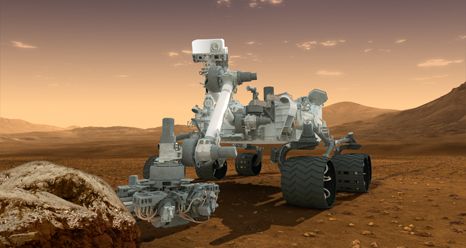
Is NASA about to announce discovery of Martian fossils by Curiosity Rover?

NASA is about to make a big announcement from its Curiosity Rover Mars mission according to John Grotzinger, its principal investigator. Will it be a giant leap forward in the search for life on Mars? Speculation began soon after Grotzinger gave an interview on NPR public radio on November 20 where he said: “This data is gonna be one for the history books. It’s looking really good.”   In the NPR interview, Grotzinger said it would be several weeks before his team would announce their finding. A clue as to what was discovered is that the data comes from Curiosity’s Sample Analysis at Mars instrument– basically an onboard chemistry lab that is capable of identifying organic compounds – the carbon-containing building blocks of life as we know it. While organic compounds do not necessarily mean that life exists/existed on Mars, they are a vital ingredient in the formation of life. NASA’s big upcoming announcement is most likely to be that it has discovered organic compounds on Mars – possibly, the fossilized remains of ancient Martian microbes.
NASA has been here before. In August 1996, David McKay and a team of NASA scientists published their analysis of a Martian meteorite discovered in Antarctica. The meteorite was found to have carbon compounds that looked very much like fossil remains of ancient Martian microbes. Here is how Mackay explained their findings:
The carbonate globules are similar in texture and size to some terrestrial bacterially induced carbonate precipitates. Although inorganic formation is possible, formation of the globules by biogenic processes could explain many of the observed features, including the PAHs [polycyclic aromatic hydrocarbons]. The PAHs, the carbonate globules, and their associated secondary mineral phases and textures could thus be fossil remains of a past martian biota.
The announcement was big news at the time, and led to President Clinton making a statement:
It is well worth contemplating how we reached this moment of discovery. More than 4 billion years ago this piece of rock was formed as a part of the original crust of Mars. After billions of years it broke from the surface and began a 16 million year journey through space that would end here on Earth. It arrived in a meteor shower 13,000 years ago. And in 1984 an American scientist on an annual U.S. government mission to search for meteors on Antarctica picked it up and took it to be studied. Appropriately, it was the first rock to be picked up that year — rock number 84001. Today, rock 84001 speaks to us across all those billions of years and millions of miles. It speaks of the possibility of life. If this discovery is confirmed, it will surely be one of the most stunning insights into our universe that science has ever uncovered. Its implications are as far-reaching and awe-inspiring as can be imagined. Even as it promises answers to some of our oldest questions, it poses still others even more fundamental.
The 1996 discovery then got bogged down in scientific debate over whether or not the meteorite was polluted by Earth microbes. Critics claimed NASA scientists had not sufficiently accounted for this possibility. Not so according to a new 2009 study by NASA scientists, including McKay, from the Johnson Space Center that upheld the earlier findings and concluded: “None of the original features supporting our hypothesis for ALH84001 has either been discredited or has been positively ascribed to non-biologic explanations.”
The continuing debate over the 1996 Mars meteorite has led to Grotzinger and his team taking a cautious approach to announcing the results of their analysis of the data sent back by Curiosity’s SAM instrument. If, as Grotnzinger suggests, the results are upheld, we will soon hear that organic compounds have been found on Mars. More importantly, they might be the fossil remnants of ancient microbiological life. You can then expect President Obama following in the footsteps of President Clinton, and make his own public announcement concerning the implications of ancient life on Mars.
© Copyright 2012. Michael E. Salla. Exopolitics.org
Permission is granted to include extracts of this article on websites and email lists with a link to the original. This article is copyright © and should not be added in its entirety on other websites or email lists without author’s permission.
Further Reading
- What Obama’s reelection means for UFO extraterrestrial disclosure
- Life on Mars – is Curiosity a step forward or backward in finding an answer?
- 1976 life on Mars controversy resurrected in new scientific report
- Kepler confirms first exoplanet in habitable region – the exopolitical impact